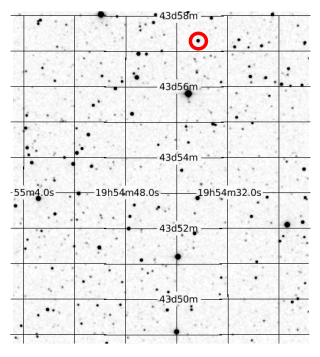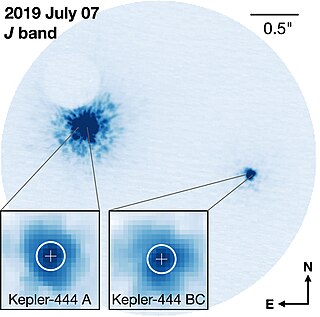Related Research Articles

In astronomy and astrobiology, the habitable zone (HZ), or more precisely the circumstellar habitable zone (CHZ), is the range of orbits around a star within which a planetary surface can support liquid water given sufficient atmospheric pressure. The bounds of the HZ are based on Earth's position in the Solar System and the amount of radiant energy it receives from the Sun. Due to the importance of liquid water to Earth's biosphere, the nature of the HZ and the objects within it may be instrumental in determining the scope and distribution of planets capable of supporting Earth-like extraterrestrial life and intelligence.

A Super-Earth is a type of exoplanet with a mass higher than Earth's, but substantially below those of the Solar System's ice giants, Uranus and Neptune, which are 14.5 and 17 times Earth's, respectively. The term "super-Earth" refers only to the mass of the planet, and so does not imply anything about the surface conditions or habitability. The alternative term "gas dwarfs" may be more accurate for those at the higher end of the mass scale, although "mini-Neptunes" is a more common term.
Kepler-20 is a star about 934 light-years from Earth in the constellation Lyra with a system of at least five, and possibly six, known planets. The apparent magnitude of this star is 12.51, so it cannot be seen with the unaided eye. Viewing it requires a telescope with an aperture of 15 cm (6 in) or more. It is slightly smaller than the Sun, with 94% of the Sun's radius and about 91% of the Sun's mass. The effective temperature of the photosphere is slightly cooler than that of the Sun at 5466 K, giving it the characteristic yellow hue of a stellar class G8 star. The abundance of elements other than hydrogen or helium, what astronomers term the metallicity, is approximately the same as in the Sun. It may be older than the Sun, although the margin of error here is relatively large.
Kepler-70, also known as KIC 5807616 and KOI-55, is a star about 3,600 light-years away in the constellation Cygnus, with an apparent visual magnitude of 14.87. This is too faint to be seen with the naked eye; viewing it requires a telescope with an aperture of 40 cm (20 in) or more. A subdwarf B star, Kepler-70 passed through the red giant stage some 18.4 million years ago. In its present-day state, it is fusing helium in its core. Once it runs out of helium it will contract to form a white dwarf. It has a relatively small radius of about 0.2 times the Sun's radius; white dwarfs are generally much smaller. The star may be host to a planetary system with two planets, although later research indicates that this is not in fact the case.

Kepler-42, formerly known as KOI-961, is a red dwarf located in the constellation Cygnus and approximately 131 light years from the Sun. It has three known extrasolar planets, all of which are smaller than Earth in radius, and likely also in mass.

Kepler-37, also known as UGA-1785, is a G-type main-sequence star located in the constellation Lyra 209 light-years from Earth. It is host to exoplanets Kepler-37b, Kepler-37c, Kepler-37d and possibly Kepler-37e, all of which orbit very close to it. Kepler-37 has a mass about 80.3 percent of the Sun's and a radius about 77 percent as large. It has a temperature similar to that of the Sun, but a bit cooler at 5,357 K. It has about half the metallicity of the Sun. With an age of roughly 6 billion years, it is slightly older than the Sun, but is still a main-sequence star. Until January 2015, Kepler-37 was the smallest star to be measured via asteroseismology.
Kepler-37d is an exoplanet discovered by the Kepler space telescope in February 2013. It is located 209 light years away, in the constellation Lyra. With an orbital period of 39.8 days, it is the largest of the three known planets orbiting its parent star Kepler-37.

Kepler-78 is a 12th magnitude star 407 light-years away in the constellation Cygnus. Initially classified as an eclipsing binary with orbital period 0.710015 days, it was later re-classified as a single star with significant interaction between star magnetosphere and close-in planet. The radius of the star is of about 74% of the Sun, and the effective temperature is about 5100 K.

Kepler-186 is a main-sequence M1-type dwarf star, located 177.5 parsecs away in the constellation of Cygnus. The star is slightly cooler than the sun, with roughly half its metallicity. It is known to have five planets, including the first Earth-sized world discovered in the habitable zone: Kepler-186f. The star hosts four other planets discovered so far, though they all orbit interior to the habitable zone.

Kepler-444 is a triple star system, estimated to be 11.2 billion years old, approximately 119 light-years (36 pc) away from Earth in the constellation Lyra. On 27 January 2015, the Kepler spacecraft is reported to have confirmed the detection of five sub-Earth-sized rocky exoplanets orbiting the main star. The star is a K-type main sequence star. All of the planets are far too close to their star to harbour life forms.

K2-3d, also known as EPIC 201367065 d, is a confirmed exoplanet of probable mini-Neptune type orbiting the red dwarf star K2-3, and the outermost of three such planets discovered in the system. It is located 143 light-years away from Earth in the constellation of Leo. The exoplanet was found by using the transit method, in which the dimming effect that a planet causes as it crosses in front of its star is measured. It was the first planet in the Kepler "Second Light" mission to receive the letter "d" designation for a planet. Its discovery was announced in January 2015.
K2-72 is a cool red dwarf star of spectral class M2.7V located about 217 light-years away from the Earth in the constellation of Aquarius. It is known to host four planets, all similar in size to Earth, with one of them residing within the habitable zone.

K2-33 is an extremely young pre-main-sequence star located about 453 light-years (139 pc) away from the Earth in the constellation of Scorpius. It is known to host one planet, a super-Neptune, named K2-33b. It is also notable for its young age.
Kepler-1652b is a super-Earth exoplanet, orbiting within the habitable zone of the red dwarf Kepler-1652 about 822 light-years away in the Cygnus constellation. Discovered by NASA's Kepler spacecraft, Kepler-1652b was first announced as a candidate in 2013, but wasn't validated until four years later in 2017. It is a potential super-Earth with 160% Earth's radius. The planet orbits well within the habitable zone of its system, the region where liquid water can exist on a planet's surface. The planet is an eyeball planet candidate.
K2-148b is a confirmed super-Earth, probably rocky, closely orbiting a small orange dwarf star. It is the innermost of three Super-Earths around the star K2-148, which is in a wide binary pair with the M0.5V red dwarf EPIC 220194953. K2-148b is the smallest planet of the system, at about a third larger than Earth, and could be terrestrial in nature. However, the three planets do not exhibit significant transit timing variations, implying that they could have relatively low masses. The planet was validated in early 2018 by Hirano et al. and is too hot for known life.

HD 179070, also known as Kepler-21, is a star with a closely orbiting exoplanet in the northern constellation of Lyra. At an apparent visual magnitude of 8.25 this was the brightest star observed by the Kepler spacecraft to host a validated planet until the discovery of an exoplanet orbiting HD 212657 in 2018. This system is located at a distance of 354 light-years from the Sun based on parallax measurements, but is drifting closer with a radial velocity of −18.2 km/s.

K2-288Bb is a super-Earth or mini-Neptune exoplanet orbiting in the habitable zone of K2-288B, a low-mass M-dwarf star in a binary star system in the constellation of Taurus about 226 light-years from Earth. It was discovered by citizen scientists while analysing data from the Kepler spacecraft's K2 mission, and was announced on 7 January 2019. K2-288 is the third transiting planet system identified by the Exoplanet Explorers program, after the six planets of K2-138 and the three planets of K2-233.
K2-315b is an exoplanet located 185.3 light years away from Earth in the southern zodiac constellation Libra. It orbits the red dwarf K2-315.
Kepler-167 is a K-type main-sequence star located about 1,119 light-years (343 pc) away from the Solar System in the constellation of Cygnus. The star has about 78% the mass and 75% the radius of the Sun, and a temperature of 4,884 K. It hosts a system of four known exoplanets. There is also a companion red dwarf star at a separation of about 700 AU, with an estimated orbital period of over 15,000 years.
HD 260655 is a relatively bright and cool M0 V red dwarf star located 33 light-years away from the Solar System in the constellation of Gemini. HD 260655 has two confirmed rocky planets, named HD 260655 b and HD 260655 c, that were discovered in 2022. Both planets were detected by the TESS mission and confirmed independently with archival and new precise radial velocity data obtained with the HIRES observatory since 1998, and the CARMENES survey instruments since 2016.
References
- 1 2 3 4 5 6 7 8 Vallenari, A.; et al. (Gaia collaboration) (2023). "Gaia Data Release 3. Summary of the content and survey properties". Astronomy and Astrophysics. 674: A1. arXiv: 2208.00211 . Bibcode:2023A&A...674A...1G. doi: 10.1051/0004-6361/202243940 . S2CID 244398875. Gaia DR3 record for this source at VizieR.
- 1 2 3 4 5 6 7 8 9 10 11 12 13 Diez Alonso, E; Gonzalez Hernandez, J. I; Suarez Gomez, S. L; Aguado, D. S; Gonzalez Gutierrez, C; Suarez Mascareno, A; Cabrera-Lavers, A; Gonzalez-Nuevo, J; Toledo Padron, B; Gracia, J; de Cos Juez, F. J; Rebolo, R (2018). "Two planetary systems with transiting Earth-size and super-Earth planets orbiting late-type dwarf stars". Monthly Notices of the Royal Astronomical Society: Letters. 480 (1): L1. arXiv: 1806.01181 . Bibcode:2018MNRAS.480L...1D. doi:10.1093/mnrasl/sly102. S2CID 102334726.
- ↑ Mike Wehner (8 June 2018). "Astronomers spot a trio of Earth-sized planets orbiting a distant star" . Retrieved 2018-06-19.

